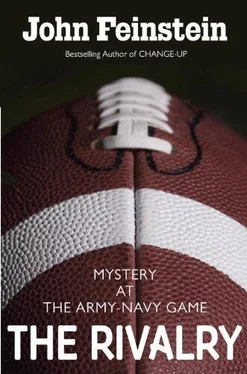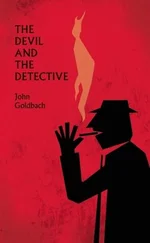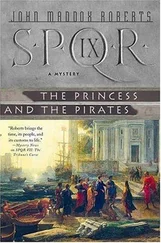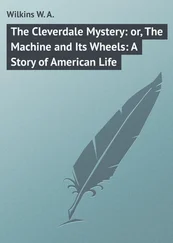They had played sixty minutes-almost twenty-five of them with real referees-and the score was tied 24-24.
They would decide the game in overtime.
“NOW WHAT?” Stevie said.
“Now we watch them go at it some more,” she said. “Then we watch them stand together and cry during the alma maters no matter who wins the game.”
“I don’t want it to ever end,” Stevie said.
She nodded, her eyes shining. “It’s exactly the way it should be, isn’t it?” She smiled. “And best of all, you and I get to watch it together.”
As usual, she was right. Being a part of Army-Navy was like nothing else he’d ever done in his life. But seeing it up close with his arm around Susan Carol made it just about perfect.
The Army-Navy rivalry began in 1890 when Cadet Dennis Michie accepted a challenge from the Naval Academy and the two teams faced off on the Plain at West Point. Navy won that game 24-0 in front of a crowd of five hundred.
By 1893, the crowds had swelled to eight thousand, and stores and offices were closed in Annapolis so that people could attend the game.
But football then was a brutal game with few rules and many injuries. And the fans were just as violent! After Navy’s victory in 1893, a rear admiral and a brigadier general got into a dispute about the game that nearly led to a duel. President Grover Cleveland stepped in and put a halt to the rivalry to try to defuse the situation.
But in 1897, Theodore Roosevelt, then assistant secretary of the navy, wrote an impassioned plea to have the game reinstated.
The rivalry picked up again in 1899 on neutral ground-at Franklin Field, in Philadelphia, where Army beat Navy 17-5 in front of a crowd of twenty-seven thousand.
In 1901, Theodore Roosevelt was president of the United States, and he became the first president to attend the Army-Navy game-and he began the tradition of switching sides of the field at halftime.
Football was still a brutal sport, and there was talk of banning intercollegiate football altogether-especially after the 1905 season, in which there were nineteen fatalities nationwide. But President Roosevelt worked to enact new safety rules and require equipment to reduce casualties, keeping the game alive.
Here’s How the Rivalry Stands After the 2009 Game
The Army-Navy game has been played 110 times.
Navy leads the series with 54 wins. Army has 49 wins. And 7 games have ended in a tie.
The biggest margin of victory came in 1973 when Navy shut out Army 51-0.
Navy is dominating the series right now-it has won the past eight games.
National Championships
The Cadets of Army and the Midshipmen of Navy have not contended for the national title in recent years. Both schools’ exacting academic requirements and the players’ military commitment following graduation mean that the teams are not made up of many NFL hopefuls. But both teams have had their powerhouse moments.
Army was national champion in 1914, 1944, and 1945-ending each of those years undefeated.
Navy holds a share of the 1926 national championship title-one of three undefeated teams that year.
Each of these championship teams was a standout.
In 1914, Army’s victory over Navy capped its first undefeated season. On the team that year as a student assistant was future president Dwight D. Eisenhower. Eisenhower was a running back and linebacker in 1912, but a knee injury following a tackle forced him off the field and onto the sidelines.
In 1926, the game was played in Chicago for the first-and only-time. Soldier Field was being dedicated as a monument to the servicemen who fought in World War I, and there seemed no more fitting way to mark this than with the Army-Navy game. Navy came into the game undefeated and Army had lost just once that year, to Notre Dame. The teams battled to a 21-21 tie before a crowd of over a hundred thousand.
The 1944 game was played during wartime, and the Army team traveled to Municipal Stadium in Baltimore by steamer ship-under escort from Navy warships guarding against submarine attacks. Army went into this game ranked number one in the country, and Navy was ranked number two. Army’s 23-7 win gave them the national title. In order to get a ticket to this game, fans also had to purchase a war bond, and $58,637,000 was raised.
Both teams were ranked one and two the next year as well, and the 1945 game was labeled the “game of the century” before it was even played. Army won again-cementing their third national title. Playing in that game were two of Army’s Heisman Trophy winners: Doc Blanchard and Glenn Davis.
Heisman Trophy Winners and Other Famous Players
Five players from Army and Navy have won the Heisman Trophy for the most outstanding collegiate football player of the year:
Doc Blanchard, Army, Fullback, 1945
Glenn Davis, Army, Halfback, 1946
Pete Dawkins, Army, Halfback, 1958
Joe Bellino, Navy, Halfback, 1960
Roger Staubach, Navy, Quarterback, 1963
Army boasts 24 players and 4 coaches in the College Football Hall of Fame.
Navy has 19 players and 3 coaches in the College Football Hall of Fame.
But only one player from either academy has gone on to the Pro Football Hall of Fame: Roger Staubach of Navy.
Thomas J. Hamilton, Navy class of 1927. Hamilton was a halfback on the 1926 national championship team. After serving on the USS Enterprise in World War II, he went on to be head coach and athletic director at both the Naval Academy and the University of Pittsburgh.
Doc Blanchard, Army class of 1947. During his three years playing for Army, his team’s record was 27-0-1, with the one tie a famous 0-0 duel with Notre Dame. Notre Dame coach Ed McKeever was so impressed with Blanchard after Army’s 59-0 win in 1944 that he said, “I’ve just seen Superman in the flesh. He wears number 35 and goes by the name of Blanchard.” Blanchard and his teammate Glenn Davis were a devastating pair of rushers, with Blanchard known as “Mr. Inside” to Davis’s “Mr. Outside.” They appeared together on the cover of Time magazine in 1945. That year, Blanchard won the Heisman Trophy, the Maxwell Award, and the James E. Sullivan Award. He was the first junior ever to win the Heisman. Blanchard was third overall in the 1946 NFL draft, but chose a military career instead. He became a fighter pilot with the air force and served in the Vietnam War. He retired from service in 1971 as a colonel.
Glenn Davis, Army class of 1947. This halfback was known as “Mr. Outside” and won the Maxwell Award in 1944 and the Heisman in 1946. In 1944, Davis led the nation with 120 points scored and 59 touchdowns. He averaged 8.3 yards per carry throughout his career, and during the 1945 season he averaged an amazing 11.5 yards per carry-both are records that still stand today. After serving in the military, Davis played for the Los Angeles Rams, but a knee injury ended his football career.
Pete Dawkins, West Point class of 1959. Dawkins won the Heisman Trophy and the Maxwell Award in 1958. He is the only cadet in history to simultaneously be a brigade commander, president of his class, captain of the football team, and a “star man”-in the top five percent of his class academically. Dawkins went on to be a Rhodes scholar, earning a degree from Oxford, and later earned a PhD from Princeton. Pete Dawkins served as a paratrooper and received two bronze stars during the Vietnam War. He ended his twenty-four-year military career as a brigadier general.
Joe Bellino, Navy class of 1961. Bellino won the Heisman Trophy in 1960. After serving in the military, he went on to play three seasons as a kick returner for the Boston Patriots. He has the somewhat dubious distinction of being the lowest-drafted Heisman winner in the history of the NFL.
Читать дальше












